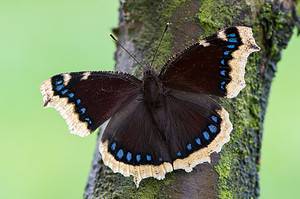Butterflies are some of the most beautiful creatures on this planet. They enthrall people with their delicacy, innocence, and jewel-like colors.
They’re not only beautiful, but as pollinators of all sorts of plants, they’re necessary. Some butterflies have always been rare, but due to habitat destruction, pollution, and climate change, too many of them are endangered as well.

Here is a list of some of the rarest types of butterflies:
10. Blue Morpho
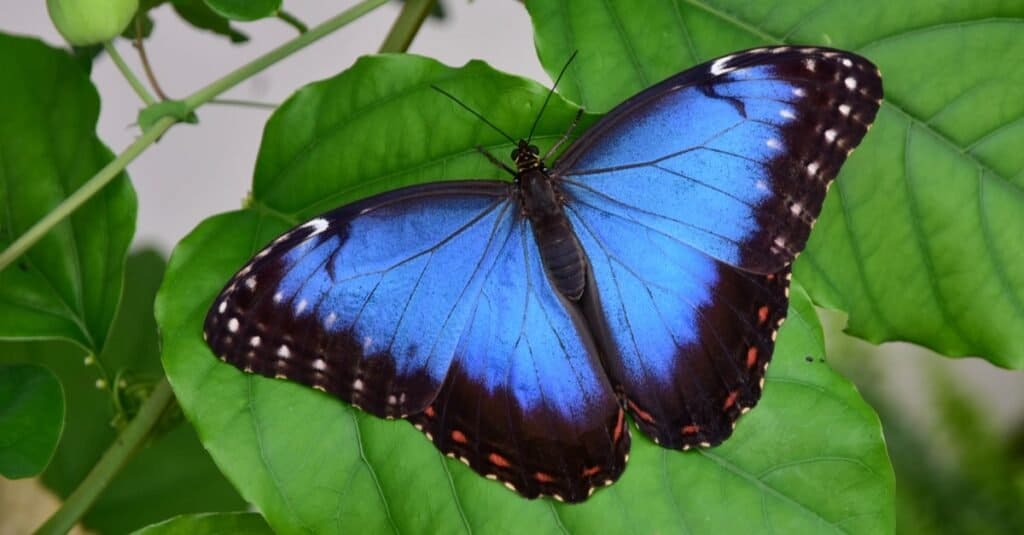
©Cristian Gusa/Shutterstock.com
With a 5.5-inch wingspan, this big, gorgeous sapphire blue butterfly is native to the rainforests of Central and South America. Both males and females have iridescent blue wings, though the wings of the females are edged in brown and have white spots.
The undersides of the wings are brown with orange eyespots outlined in bronze and brown, and the wings of the females have a broken bronze band. Males like to chase each other through the rainforest and one way collectors catch them is to wave a blue piece of cloth where they can see it. The blue morpho feeds on the juices of rotting fruit.
The red and green caterpillar is nocturnal and fond of the leaves of Erythroxylum and members of the pea family. This butterfly is endangered due to habitat loss and collection.
9. Island Marble Butterfly

Island marble butterfly sitting on a leaf. Although several small populations have been found in recent years, there is only one potentially viable population of approximately 200 island marble butterflies.
This butterfly is endemic to Washington state’s San Juan Islands. Once believed to be extinct, it was found in 1998 and has been listed as endangered since 2020. It’s a subspecies of a butterfly called the Large Marble.
The Island Marble’s wings have a fascinating color scheme of marbled green and white, and it feeds on the flowers of the wild mustard. It has a wingspan of between 1.5 and 2 inches, and the caterpillar is about 3/4 of an inch long. It’s green or blue-gray and dotted in black with white with yellow stripes down its back and sides.
The butterfly’s ideal habitat seems to be the prairie, but prairies, like the butterfly itself are becoming rarer and rarer. Scientists believe there are only about 200 of these butterflies left in the wild.
8. Schaus Swallowtail
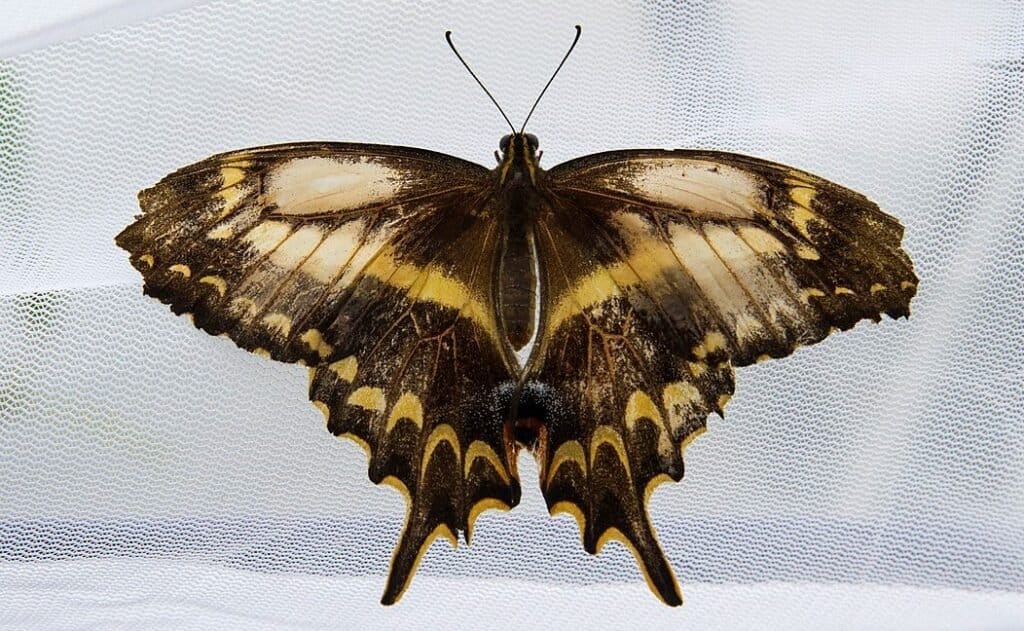
©U.S. Fish and Wildlife Service Southeast Region / Creative Commons – License
Native to southern Florida down into the Caribbean, this swallowtail has a 3.25 to 3.75-inch wingspan and blackish-brown wings with yellow markings. The underside of the hindwings has a rust-colored patch decorated with powdery blue blotches.
The females and males can be told apart because the female has all-black antennae while the males are black and tipped with yellow. The butterfly is famous for being able to fly great distances, which means that it can hop from one of the Florida Keys to the other.
At one time there were only a few hundred butterflies in Florida, but thanks to a captive breeding program, there are about 800 to 1200 butterflies in the wild. Still, the Schaus swallowtail’s conservation status is vulnerable and it’s now only found in southern Florida.
7. Kaiser-i-Hind

©Danita Delimont/Shutterstock.com
Also called the Emperor of India, this butterfly is found in the eastern Himalayan mountains and is unmistakable because it is largely a lush, grass green. Scientists are still trying to puzzle out how the scales on the wings produce such a vivid color.
Males can be told from females because they’re smaller than females and have a yellow patch on the hind wing. The female also has more tails on her hindwing, and she’s a bit duskier. The caterpillar eats the leaves of Daphne shrubs.
Because the butterfly has such spectacular looks it is sought after by collectors even though it is protected by both India and Nepal. The butterfly, which is related to similar types of butterflies and is hard to tell apart from them, lives at altitudes of 6,000 and 10,000 feet. Its status is near threatened.
6. Zebra Longwing
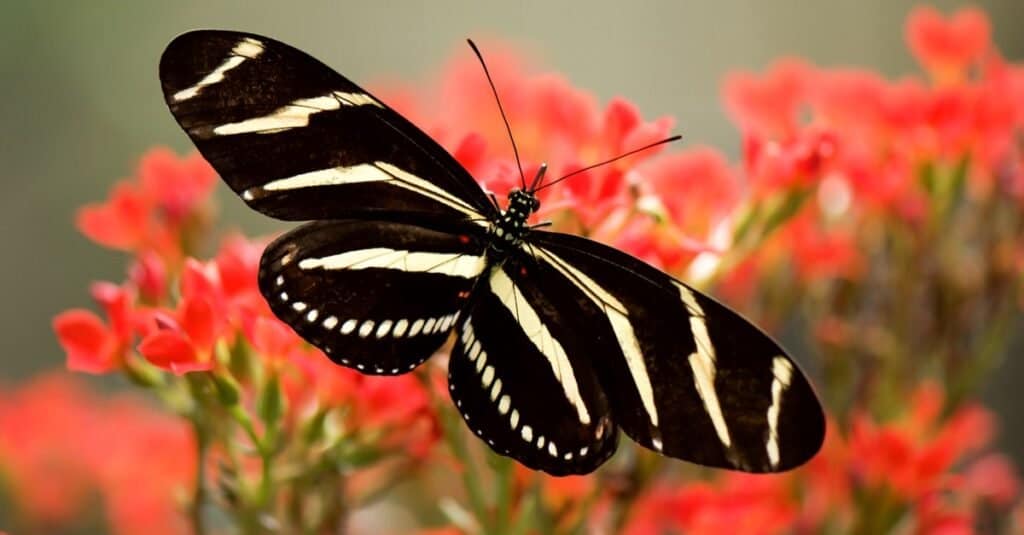
©Julee75/Shutterstock.com
The coloration of this butterfly reminds people of the black and white stripes of a zebra even though if you look closely there are red spots at the base of the wings, which have a span of 2.8 to 3.9 inches. It is native to South and Central America and can be found in some parts of the southern United States. This makes its range unusually large for a butterfly.
The zebra longwing roosts in large groups to protect against predators. Moreover, they are unusual for butterflies in that they eat pollen, and their bodies transform it into chemicals that make the butterfly toxic. Not only this, the ingestion of pollen makes the zebra longwing live much longer than other butterflies.
As of 2021, the butterfly’s conservation status is secure, but pesticides have devastated its Florida population. Like honeybees, the butterfly has also suffered colony collapse.
5. Chimaera Birdwing
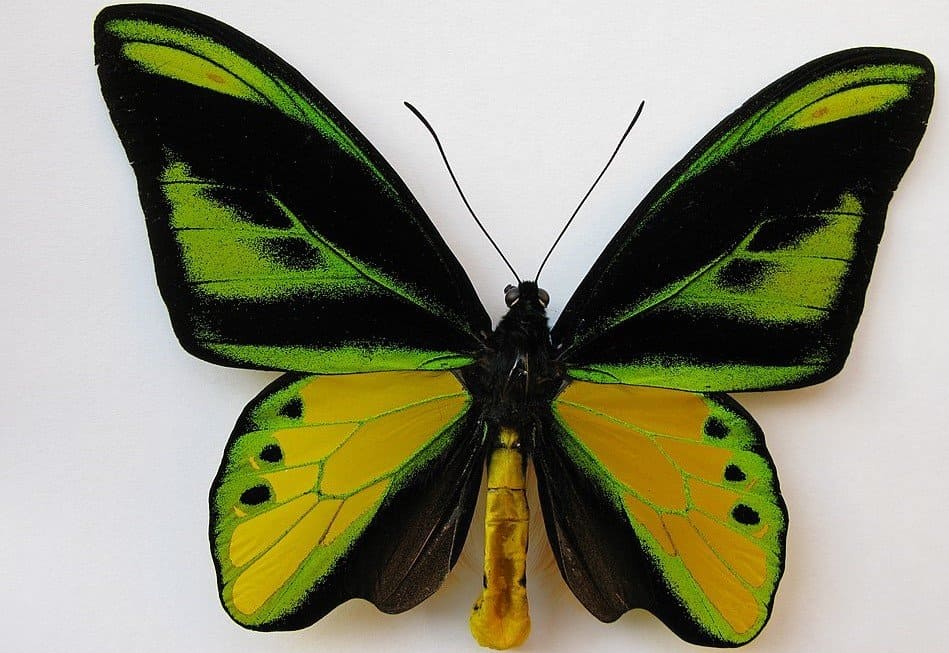
©Anaxibia / Creative Commons – License
This large and sensationally colorful butterfly is found in the mountains of New Guinea. The male is brilliant green and yellow, with splashes of black. The female, who’s bigger than the male, is dark brown with white spots on her forewings. Her hindwings are mostly white and spotted with black.
The wingspan of the Chimaera birdwing is 2.76 to 5.9 inches in males and 3.15 to 7.09 inches in females. The adults sip nectar from Spathodea and hibiscus plants while the caterpillars eat the leaves of the pipevine. As can be expected, collectors are eager for this butterfly, but a permit is required to collect it. As of 2021, it is considered near threatened.
Go here for more information about the Chimaera birdwing.
4. Bhutan Glory
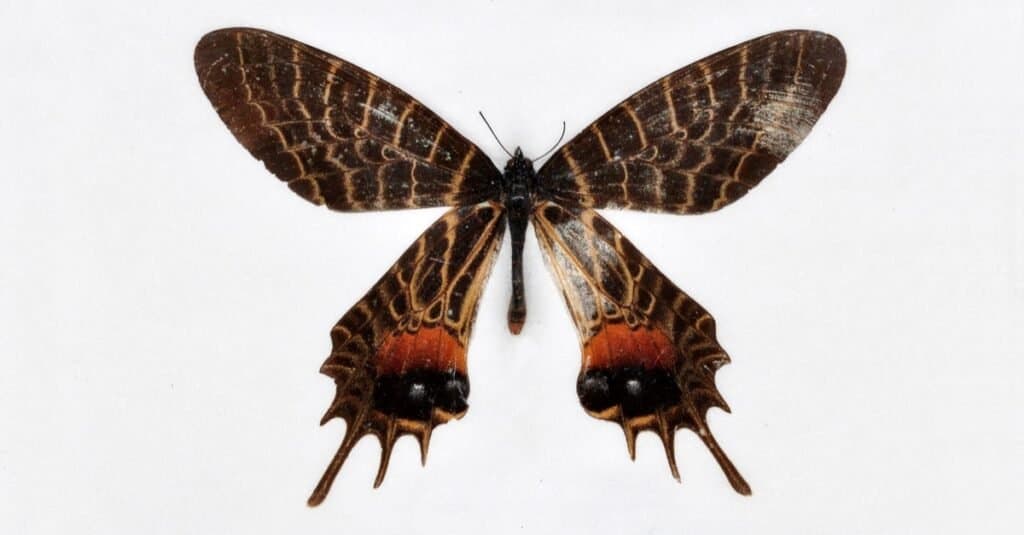
©Butterfly Hunter/Shutterstock.com
The Bhutan glory is a swallowtail butterfly, but it’s unusual in that its forewings are oval-shaped. The edge of the wing that’s farthest from the body is convex, and the hindwings have many tails. The overall color of this butterfly is black, but it is adorned with wavy white or cream vertical lines.
The hindwings have a large orange patch, there are blue-black and white eyespots and spots of yellow right above the tails. It’s found in the Himalayan mountains at elevations of between 5000 and 9000 feet and has a flight that’s described as drifting. The caterpillar eats species of the pipevine, which probably makes it bad-tasting to predators.
Though its conservation status is least concern, the Bhutan Glory’s population is decreasing due to habitat loss.
3. Queen Alexandra’s Birdwing

©Russell Marshall/Shutterstock.com
Named after a Queen of England, the females of this huge butterfly can have a wingspan of between 9.8 and 11 inches and weigh as much as 0.42 ounces. Their wings are brown and white, but the smaller males are sparkling blue-green and banded in black, with a green or blue-green underside. This butterfly is only found in Papua New Guinea’s Oro Province.
Because it is so rare and endangered, the trade in these butterflies is illegal. Adults feed on hibiscus and other plants strong enough to support their weight early in the morning and early in the evening. Males are territorial and will even see off small birds. Humans aren’t the only reason that the butterfly is endangered. It still hasn’t recovered from a volcanic eruption that wiped out much of its habitat in 1951.
Interestingly enough, Queen Alexandra’s Birdwing butterflies feed on poisonous plants. However, the caterpillar is not affected by the poison and can retain it within its own body making it poisonous to other animals. Not only is it poisonous during certain phases of its life, but it’s also the largest butterfly species found to date.
For more information about Queen Alexandra’s birdwing read this.
2. Miami Blue
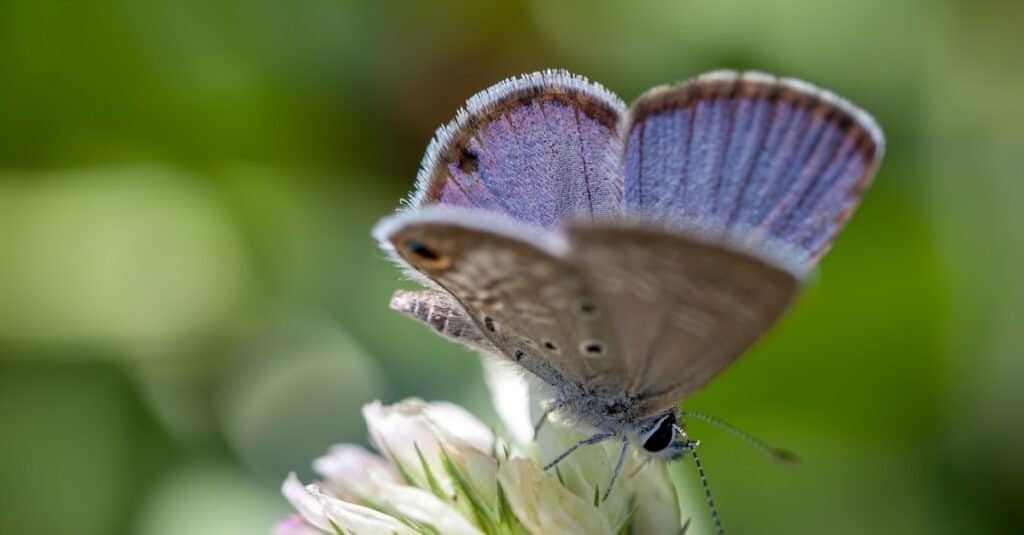
©pixelworlds/Shutterstock.com
Interestingly, a good number of endangered butterflies belong to the Lycaenidae family. These little butterflies are called blues due to the color of their wings. The population of the Miami Blue from southern Florida has taken a series of hits over the years. Once common, it was decimated by development starting in the 1980s.
Then, in 1992 Hurricane Andrew almost wiped it out altogether. Fortunately, a handful was discovered in Bahia Honda State Park in 1999. The Miami blue is now endangered though there’s a captive breeding program run by Florida’s Museum of Natural History in Gainesville.
The Miami blue has a wingspan of only 0.87 to a little over an inch. The wings, as its name says, are bright blue in the males, while they are gray with a bit of blue near the base in the females. The hind wings are edged in white and have four spots. The butterfly chooses several types of plants as host plants for its caterpillar, including blackbeads, nickerbeads, peacock flowers, and balloon vines.
1. Palos Verdes Blue

©Katerina Iacovides/Shutterstock.com
This little butterfly with its cerulean blue wings and body is in competition with the Miami blue to be the rarest butterfly in the world. A subspecies of the silvery blue, it is found in California’s Palos Verdes Peninsula.
One reason for its endangered status is that it uses only the common deer weed as a host plant, and this plant has become scarce as its habitat is being converted into housing. Because of this, homeowners in the area are encouraged to plant deer weed.
The wingspan of the Palos Verdes blue butterfly is only a little larger than that of the Miami blue, and the male’s wings are more silvery blue than those of its distant cousin.
The breeding season lasts from January to early May and coincides with the butterflies’ emergence from their pupae. This is a good thing as the Palos Verdes blue only lives five days as an adult.
Summary Of The 10 Rarest Butterflies In The World
| Rank | Butterfly Species |
|---|---|
| 10. | Blue Morpho |
| 9. | Island Marble Butterfly |
| 8. | Schaus Swallowtail |
| 7. | Kaiser-i-Hind |
| 6. | Zebra Longwing |
| 5. | Chimaera Birdwing |
| 4. | Bhutan Glory |
| 3. | Queen Alexandra’s Birdwing |
| 2. | Miami Blue |
| 1. | Palos Verdes Blue |
Honorable Mention: Other Rare Butterflies
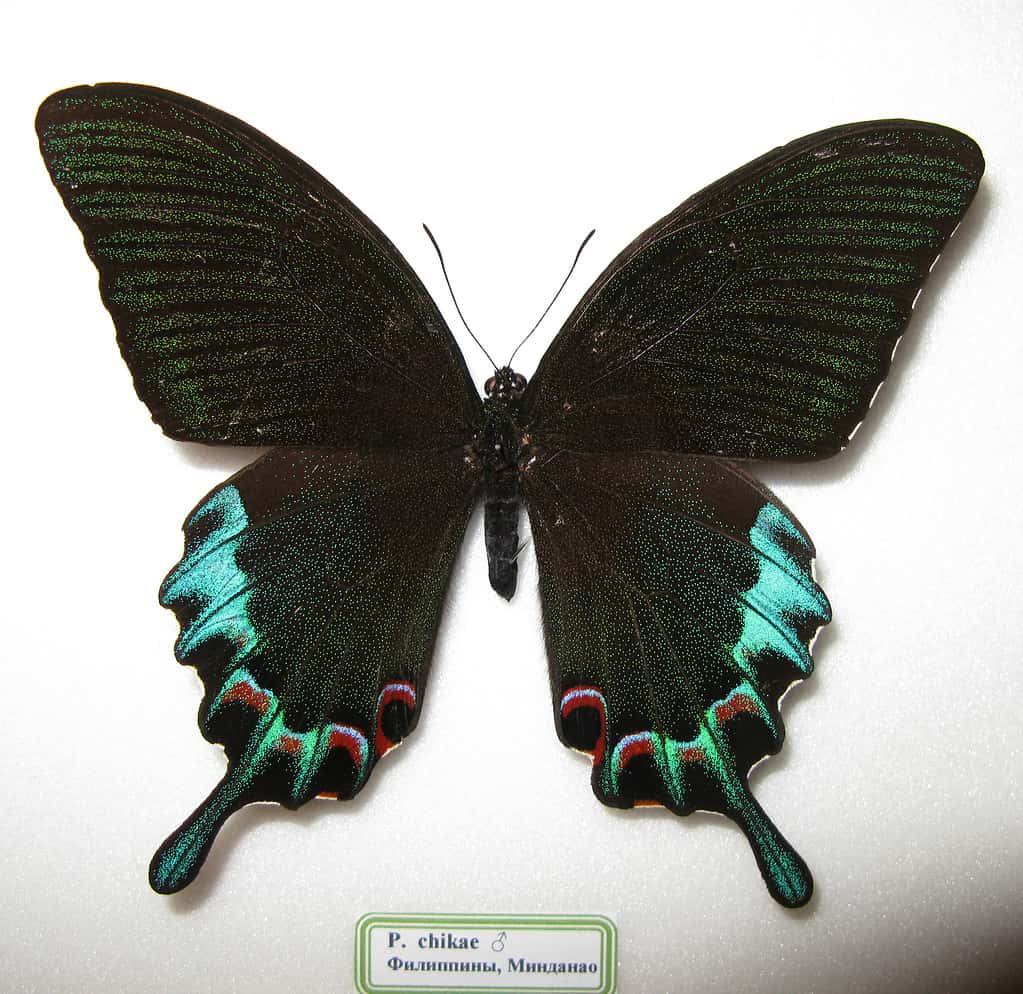
The Luzon Peacock Swallowtail
(
Papilio chikae) endemic to the Phillipines where they were first discovered in 1965.
©Anaxibia, CC BY-SA 3.0 – License
There are around 17,500 species of butterflies found throughout the word, and 750 species located in the United States. Butterflies, and moths, are the only insect group that have scales covering their wings. There are 29 species in the U.S. that are listed as endangered, with an additional six that are listed as threatened and since 1950, five species have gone extinct.
Because of their rarity, many of the species here are in danger of becoming extinct as well. Read on to see a few more butterflies that are also rare:
- Glasswing Butterfly (Greta oto) – this species of brush footed butterfly is known for its wings that are transparent and due to the lack of extensive coloration, allows it to be camouflaged. This rather large species is endemic to Bolivia, Colombia, Ecuador, and Peru, and is also known espejitos, which translates to small mirror. It is considered rare simply because it is one of the few land-based animals that has mastered the act of transparency.
- Lange’s Metalmark (Apodemia mormo langei) – this butterfly is a subspecies of the Mormon metalmark and is endemic to California, where it can be found on one small riverbank located in the San Fransisco Bay area. It was added to the federal endangered species list in 1976 and efforts are being made to stabilize its numbers. Their wings are brown and orange with white markings and adults have a wingspan that ranges from one to 1.5 inches.
- Fender’s Blue Butterfly (Icaricia icariodes fenderi) – endemic to northern Oregon where it is found in the Willamette Valley prairie, this small butterfly has a wingspan measuring between 0.9 and 1.2 inches. While it was once thought to be extinct, as no populations were spotted after the 1930s, it was rediscovered in 1989 and it currently still on the endangered species list. This is a host-specific species, who feed on a rare subspecies of common sulphur lupines known as Kincaid’s lupine (Lupinus sulphureus kincaidii).
- Luzon Peacock Swallowtail (Papilio chikae) – endemic to the Phillipines where they were first discovered in 1965, this butterfly has a coloration of mostly black with green-black, red and purple, and a long tail. It is a fairly large species, with a wingspan that measures around 2.16 inches. It is also listed as an endangered species due to its ease of capture and many tourists, as well as locals, will sell them for a profit.
The photo featured at the top of this post is © Dennis van de Water/Shutterstock.com
Thank you for reading! Have some feedback for us? Contact the AZ Animals editorial team.




